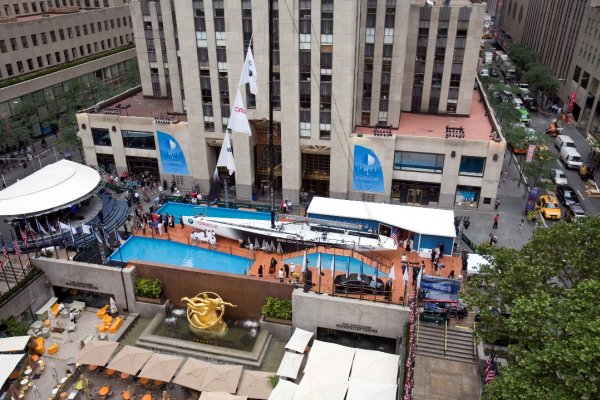
BMW Oracle Racing yacht on display in Rockefeller Center, June 2006.
Photo: ©2006 BMW Oracle Racing
BMW Oracle Racing in New York

BMW Oracle Racing yacht on
display in Rockefeller Center, June 2006.
Photo: ©2006 BMW Oracle Racing
Trivia Question: What do the America's Cup and John D. Rockefeller have in common? Answer: Thomas W. Lawson. Both were subjects of bitter print attack campaigns by the Boston attorney. The America's Cup and the New York YC came under fire following the failure of Lawson's 140-foot scow Independence to be accepted into the 1901 defender trials. In response Lawson sponsored the publication of a book titled The Lawson History of the America's Cup, which was largely a sober and scholarly history of the event, at least until it touched on Lawson's own 1901 experiences, whereupon it launched into a presentation of the facts that was decidedly partisan and not lacking in personal judgments about New York YC members either. Lawson himself authored the latter section of the book. In 1904, Lawson's apparently copious ire was turned on Standard Oil founder John D. Rockefeller. Lawson had been a partner in a stock investment scheme that included a number of Standard Oil figures. The investment turned out to be a financially rewarding one, but similar to many stock market plays of the time it involved several practices that were either illegal or unethical, if not both. Lawson wrote an insider's exposé in a series of magazine articles later collected under the title of Frenzied Finance that gained great notice, Lawson in the process effectively associating the various bad deeds with John D. Rockefeller. As it turned out, Rockefeller himself never had any money in the partnership, nor any involvement at all. Lawson apparently knew this, at least at the time he wrote his "exposé," but that was not the message the public took away from his Frenzied Finance series. Muckraking anti-trust journalism was coming to a peak and Lawson's articles did Rockefeller no small amount of damage.
Lawson's America's Cup tribulations stemmed at first from the fact that he was not a member of the NYYC. He refused to join the club and he refused even to charter the boat to a club member or to cooperate in almost any manner. The other defender candidates tried to accommodate Lawson's boat later that summer in an unofficial series that let them all race together, but the Bostonian's delicate and unconventional craft, leaking heavily, was not competitive. Despite flashes of promise from the huge scow design, which is said to have influenced Nat Herreshoff's approach to the 1903 Defender Reliance, the only place Independence was going in a hurry was the scrap yard. She was broken up before the year was out. The connection between the America's Cup and John D. Rockefeller is not what one might at first think obvious, since Rockefeller, despite being one of the richest men in the world, never owned a yacht. In fact, Rockefeller was in his private life a rather ascetic and devout Baptist, shunning alcohol, gambling, and cards, and he was not a joiner of private clubs. Although later in his life he built an extensive estate north of New York City, his own houses were much less ostentatious than other wealthy families of his day, and unusual for a man of his means Rockefeller didn't own a private railroad car. His sports passions were primarily ice skating, bicycling, and late in life, obsessive pursuit of golf. His son John D. Rockefeller, Jr., oversaw the development of Rockefeller Center in the early 1930's, and continued a pattern of extreme philanthropy begun by his father. Land for Acadia, Grand Teton, Great Smoky and other national parks, funds for restoration of Colonial Williamsburg and the chateaux of Versailles and Fontainebleau, the founding gifts for New York's Museum of Modern Art and the University of Chicago, along with uncountable less visible and often anonymous contributions were all part of the hundreds of millions of dollars that the Rockefellers gave away. John D. Rockefeller, Sr., who died a only few weeks short of his 98th birthday in 1937, lived to see his name become associated with such generous concern for the public good that animosity over the brutal anti-competitive practices that built Standard Oil faded into the history books.
Lawson's history, usually referred to by Cup fans simply as Lawson's, was published in a numbered limited edition of 3000 and became a sought-after collector's item for America's Cup bibliophiles. A reproduction edition was printed in 1986, this time 1500 numbered copies, and many Cup readers find the new printing preferable because with age the original editions typically have grown too delicate to withstand the stress of handling. While prices for both editions have been quoted as allegedly changing hands for thousands of dollars, book dealers more commonly try to ask for a price in the low hundreds, and copies have changed hands on EBay for as little as US $10. As for the man himself, Lawson's financial fortunes soon took a turn for the worse, partially as a result of his confessions in Frenzied Finance. Lawson was also the namesake for the only seven-masted schooner ever built. The Thomas W. Lawson was lost in a storm in 1907, barely five years after she was launched. The NYYC defeated Sir Thomas Lipton's challenger in 1901 and extended the winning streak of successful defenses for another 82 years. Today, 105 years later, the America's Cup continues its legendary status as the most famous yacht race in the world. BMW Oracle
Racing's visit to Rockefeller Center inadvertently (it is presumed) unites two
subjects that were "hot buttons" for a certain Boston attorney. One only
wonders what he might have to say about the pairing......... Links of
Interest: Independence: Library of Congress, Prints and Photographs Division, Detroit Publishing Company Collection. Lawson: Chicago Daily News negatives collection, DN-0050602. Courtesy of the Chicago Historical Society. |
Inquiries please contact: